Environmental Law Assignment: ICJ Advisory Opinion on Nuclear Weapons
VerifiedAdded on 2021/12/13
|11
|3077
|95
Report
AI Summary
This report examines the legality of nuclear weapons in international law, focusing on the International Court of Justice's (ICJ) 1996 advisory opinion. It analyzes the case initiated by the World Health Organization (WHO) and later addressed by the United Nations General Assembly, which questioned the permissibility of the threat or use of nuclear weapons. The report delves into the ICJ's assessment of human rights, environmental law, and the law of armed conflict. It discusses the application of principles such as the right to life, the prohibition of genocide, environmental treaties, and the laws of war. The analysis includes the court's consideration of self-defense, humanitarian law, and the concept of neutrality, ultimately highlighting the complexities and contradictions in the legal framework surrounding nuclear weapons. The report explores the court's findings on the legality of nuclear weapons, the role of international judicial bodies, and the rules governing the use of force, providing a comprehensive overview of the legal challenges posed by nuclear weapons.
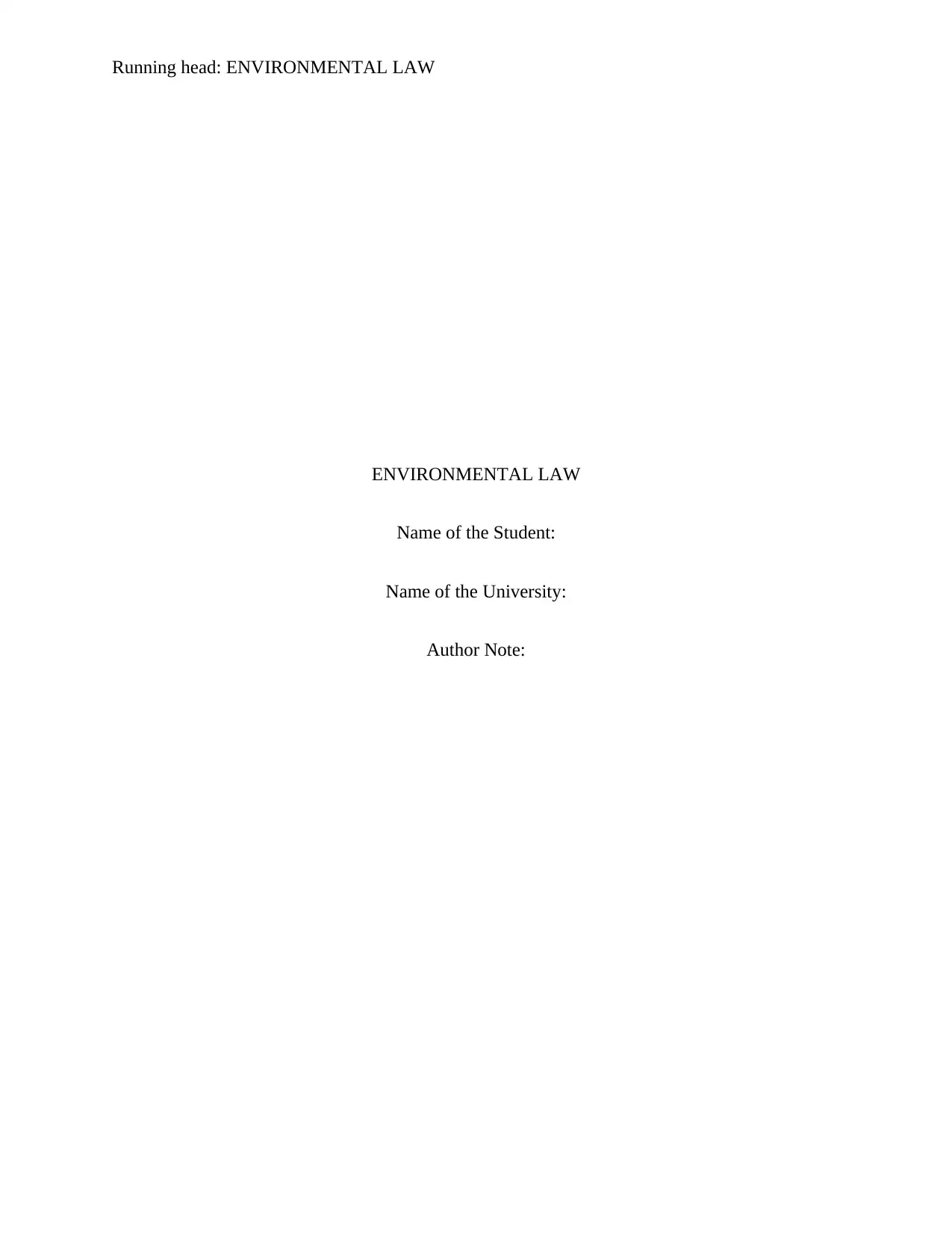
Running head: ENVIRONMENTAL LAW
ENVIRONMENTAL LAW
Name of the Student:
Name of the University:
Author Note:
ENVIRONMENTAL LAW
Name of the Student:
Name of the University:
Author Note:
Paraphrase This Document
Need a fresh take? Get an instant paraphrase of this document with our AI Paraphraser
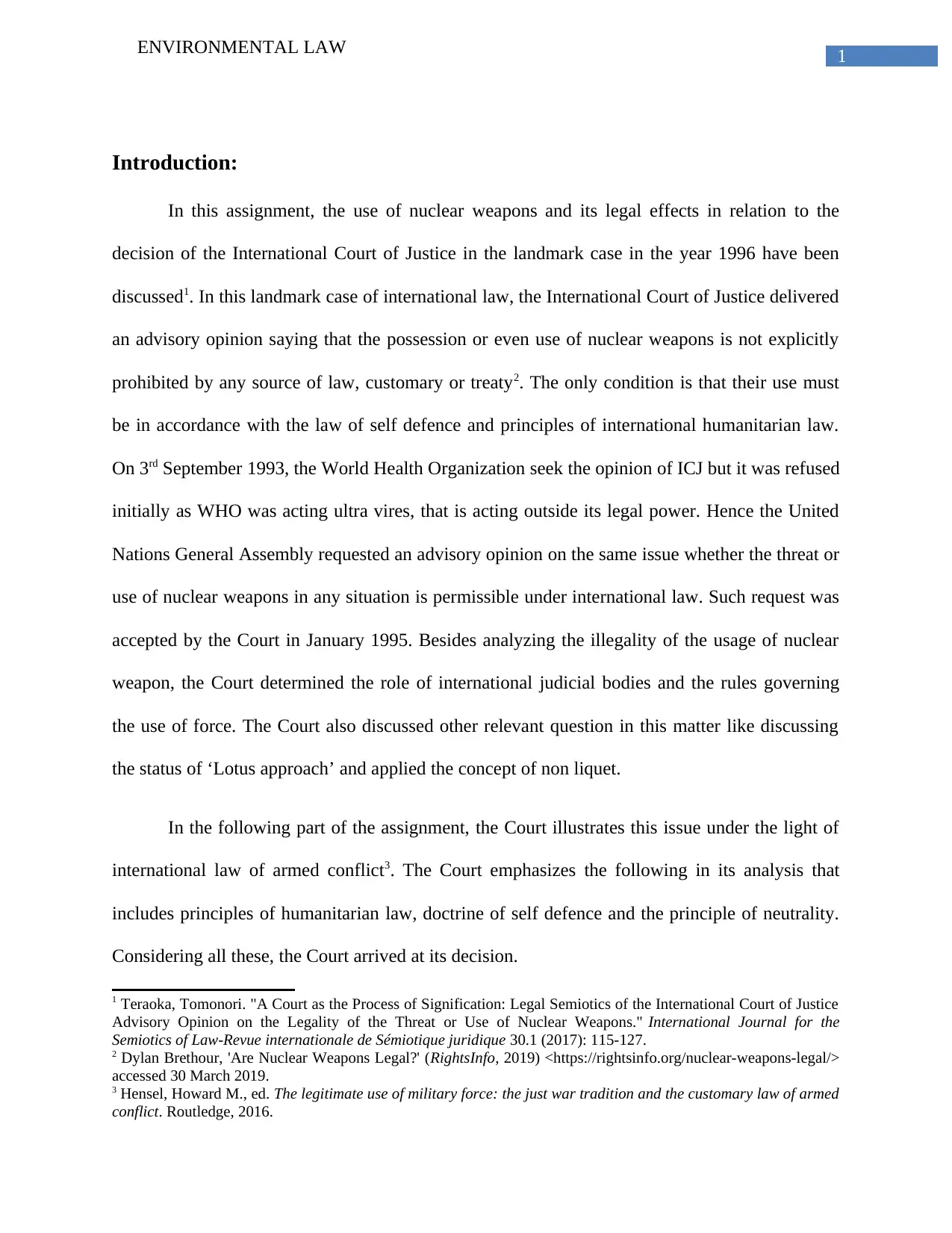
1ENVIRONMENTAL LAW
Introduction:
In this assignment, the use of nuclear weapons and its legal effects in relation to the
decision of the International Court of Justice in the landmark case in the year 1996 have been
discussed1. In this landmark case of international law, the International Court of Justice delivered
an advisory opinion saying that the possession or even use of nuclear weapons is not explicitly
prohibited by any source of law, customary or treaty2. The only condition is that their use must
be in accordance with the law of self defence and principles of international humanitarian law.
On 3rd September 1993, the World Health Organization seek the opinion of ICJ but it was refused
initially as WHO was acting ultra vires, that is acting outside its legal power. Hence the United
Nations General Assembly requested an advisory opinion on the same issue whether the threat or
use of nuclear weapons in any situation is permissible under international law. Such request was
accepted by the Court in January 1995. Besides analyzing the illegality of the usage of nuclear
weapon, the Court determined the role of international judicial bodies and the rules governing
the use of force. The Court also discussed other relevant question in this matter like discussing
the status of ‘Lotus approach’ and applied the concept of non liquet.
In the following part of the assignment, the Court illustrates this issue under the light of
international law of armed conflict3. The Court emphasizes the following in its analysis that
includes principles of humanitarian law, doctrine of self defence and the principle of neutrality.
Considering all these, the Court arrived at its decision.
1 Teraoka, Tomonori. "A Court as the Process of Signification: Legal Semiotics of the International Court of Justice
Advisory Opinion on the Legality of the Threat or Use of Nuclear Weapons." International Journal for the
Semiotics of Law-Revue internationale de Sémiotique juridique 30.1 (2017): 115-127.
2 Dylan Brethour, 'Are Nuclear Weapons Legal?' (RightsInfo, 2019) <https://rightsinfo.org/nuclear-weapons-legal/>
accessed 30 March 2019.
3 Hensel, Howard M., ed. The legitimate use of military force: the just war tradition and the customary law of armed
conflict. Routledge, 2016.
Introduction:
In this assignment, the use of nuclear weapons and its legal effects in relation to the
decision of the International Court of Justice in the landmark case in the year 1996 have been
discussed1. In this landmark case of international law, the International Court of Justice delivered
an advisory opinion saying that the possession or even use of nuclear weapons is not explicitly
prohibited by any source of law, customary or treaty2. The only condition is that their use must
be in accordance with the law of self defence and principles of international humanitarian law.
On 3rd September 1993, the World Health Organization seek the opinion of ICJ but it was refused
initially as WHO was acting ultra vires, that is acting outside its legal power. Hence the United
Nations General Assembly requested an advisory opinion on the same issue whether the threat or
use of nuclear weapons in any situation is permissible under international law. Such request was
accepted by the Court in January 1995. Besides analyzing the illegality of the usage of nuclear
weapon, the Court determined the role of international judicial bodies and the rules governing
the use of force. The Court also discussed other relevant question in this matter like discussing
the status of ‘Lotus approach’ and applied the concept of non liquet.
In the following part of the assignment, the Court illustrates this issue under the light of
international law of armed conflict3. The Court emphasizes the following in its analysis that
includes principles of humanitarian law, doctrine of self defence and the principle of neutrality.
Considering all these, the Court arrived at its decision.
1 Teraoka, Tomonori. "A Court as the Process of Signification: Legal Semiotics of the International Court of Justice
Advisory Opinion on the Legality of the Threat or Use of Nuclear Weapons." International Journal for the
Semiotics of Law-Revue internationale de Sémiotique juridique 30.1 (2017): 115-127.
2 Dylan Brethour, 'Are Nuclear Weapons Legal?' (RightsInfo, 2019) <https://rightsinfo.org/nuclear-weapons-legal/>
accessed 30 March 2019.
3 Hensel, Howard M., ed. The legitimate use of military force: the just war tradition and the customary law of armed
conflict. Routledge, 2016.
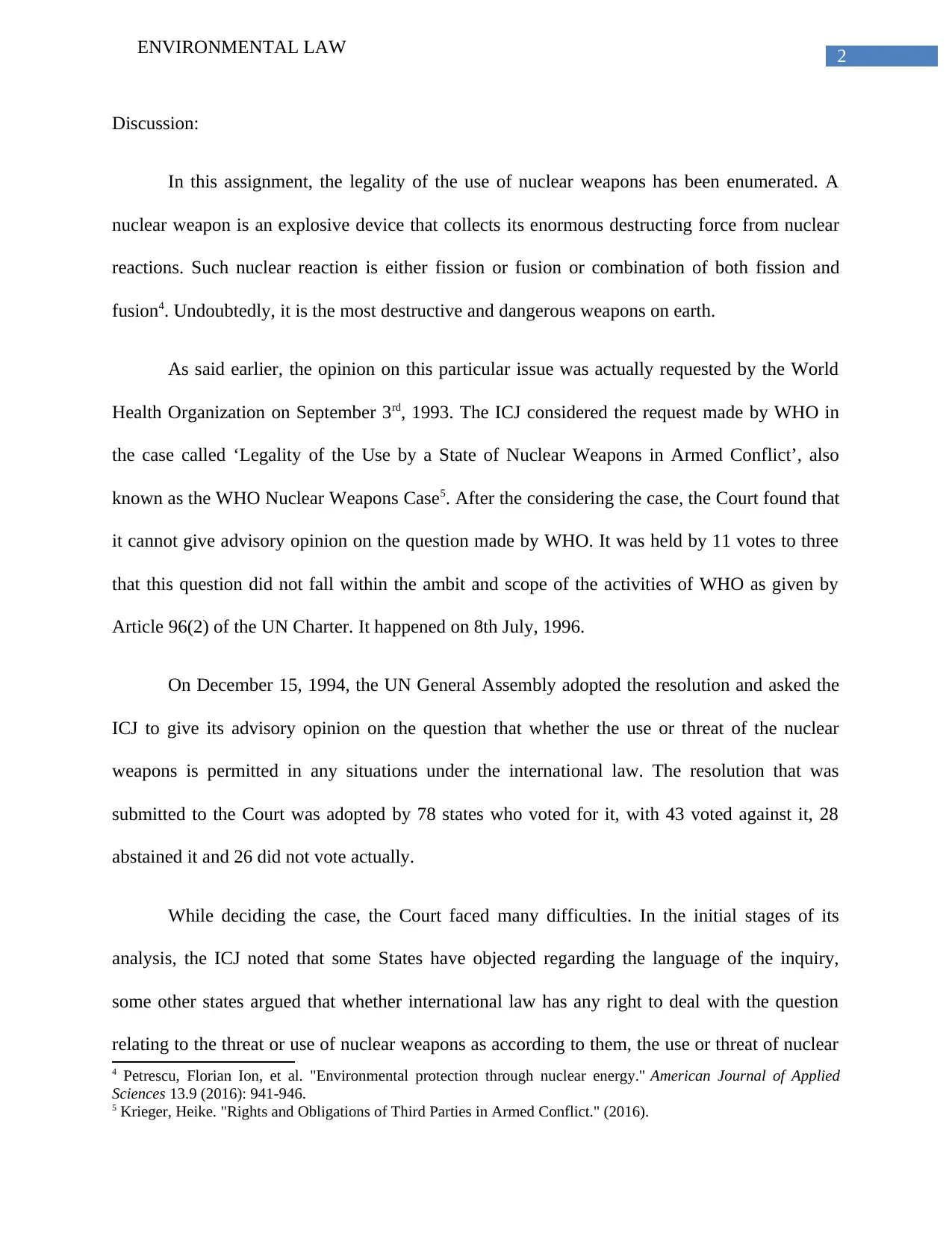
2ENVIRONMENTAL LAW
Discussion:
In this assignment, the legality of the use of nuclear weapons has been enumerated. A
nuclear weapon is an explosive device that collects its enormous destructing force from nuclear
reactions. Such nuclear reaction is either fission or fusion or combination of both fission and
fusion4. Undoubtedly, it is the most destructive and dangerous weapons on earth.
As said earlier, the opinion on this particular issue was actually requested by the World
Health Organization on September 3rd, 1993. The ICJ considered the request made by WHO in
the case called ‘Legality of the Use by a State of Nuclear Weapons in Armed Conflict’, also
known as the WHO Nuclear Weapons Case5. After the considering the case, the Court found that
it cannot give advisory opinion on the question made by WHO. It was held by 11 votes to three
that this question did not fall within the ambit and scope of the activities of WHO as given by
Article 96(2) of the UN Charter. It happened on 8th July, 1996.
On December 15, 1994, the UN General Assembly adopted the resolution and asked the
ICJ to give its advisory opinion on the question that whether the use or threat of the nuclear
weapons is permitted in any situations under the international law. The resolution that was
submitted to the Court was adopted by 78 states who voted for it, with 43 voted against it, 28
abstained it and 26 did not vote actually.
While deciding the case, the Court faced many difficulties. In the initial stages of its
analysis, the ICJ noted that some States have objected regarding the language of the inquiry,
some other states argued that whether international law has any right to deal with the question
relating to the threat or use of nuclear weapons as according to them, the use or threat of nuclear
4 Petrescu, Florian Ion, et al. "Environmental protection through nuclear energy." American Journal of Applied
Sciences 13.9 (2016): 941-946.
5 Krieger, Heike. "Rights and Obligations of Third Parties in Armed Conflict." (2016).
Discussion:
In this assignment, the legality of the use of nuclear weapons has been enumerated. A
nuclear weapon is an explosive device that collects its enormous destructing force from nuclear
reactions. Such nuclear reaction is either fission or fusion or combination of both fission and
fusion4. Undoubtedly, it is the most destructive and dangerous weapons on earth.
As said earlier, the opinion on this particular issue was actually requested by the World
Health Organization on September 3rd, 1993. The ICJ considered the request made by WHO in
the case called ‘Legality of the Use by a State of Nuclear Weapons in Armed Conflict’, also
known as the WHO Nuclear Weapons Case5. After the considering the case, the Court found that
it cannot give advisory opinion on the question made by WHO. It was held by 11 votes to three
that this question did not fall within the ambit and scope of the activities of WHO as given by
Article 96(2) of the UN Charter. It happened on 8th July, 1996.
On December 15, 1994, the UN General Assembly adopted the resolution and asked the
ICJ to give its advisory opinion on the question that whether the use or threat of the nuclear
weapons is permitted in any situations under the international law. The resolution that was
submitted to the Court was adopted by 78 states who voted for it, with 43 voted against it, 28
abstained it and 26 did not vote actually.
While deciding the case, the Court faced many difficulties. In the initial stages of its
analysis, the ICJ noted that some States have objected regarding the language of the inquiry,
some other states argued that whether international law has any right to deal with the question
relating to the threat or use of nuclear weapons as according to them, the use or threat of nuclear
4 Petrescu, Florian Ion, et al. "Environmental protection through nuclear energy." American Journal of Applied
Sciences 13.9 (2016): 941-946.
5 Krieger, Heike. "Rights and Obligations of Third Parties in Armed Conflict." (2016).
⊘ This is a preview!⊘
Do you want full access?
Subscribe today to unlock all pages.

Trusted by 1+ million students worldwide
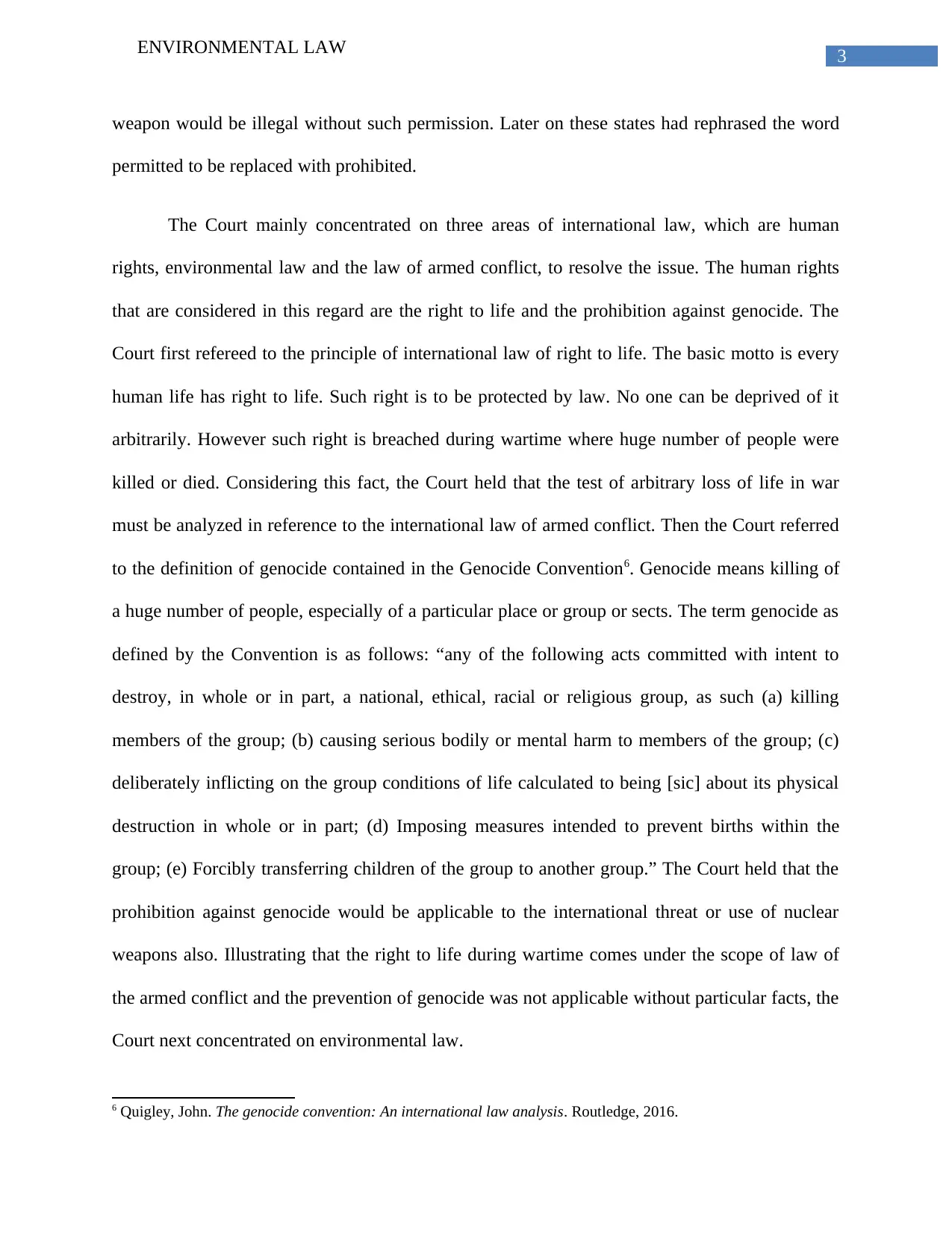
3ENVIRONMENTAL LAW
weapon would be illegal without such permission. Later on these states had rephrased the word
permitted to be replaced with prohibited.
The Court mainly concentrated on three areas of international law, which are human
rights, environmental law and the law of armed conflict, to resolve the issue. The human rights
that are considered in this regard are the right to life and the prohibition against genocide. The
Court first refereed to the principle of international law of right to life. The basic motto is every
human life has right to life. Such right is to be protected by law. No one can be deprived of it
arbitrarily. However such right is breached during wartime where huge number of people were
killed or died. Considering this fact, the Court held that the test of arbitrary loss of life in war
must be analyzed in reference to the international law of armed conflict. Then the Court referred
to the definition of genocide contained in the Genocide Convention6. Genocide means killing of
a huge number of people, especially of a particular place or group or sects. The term genocide as
defined by the Convention is as follows: “any of the following acts committed with intent to
destroy, in whole or in part, a national, ethical, racial or religious group, as such (a) killing
members of the group; (b) causing serious bodily or mental harm to members of the group; (c)
deliberately inflicting on the group conditions of life calculated to being [sic] about its physical
destruction in whole or in part; (d) Imposing measures intended to prevent births within the
group; (e) Forcibly transferring children of the group to another group.” The Court held that the
prohibition against genocide would be applicable to the international threat or use of nuclear
weapons also. Illustrating that the right to life during wartime comes under the scope of law of
the armed conflict and the prevention of genocide was not applicable without particular facts, the
Court next concentrated on environmental law.
6 Quigley, John. The genocide convention: An international law analysis. Routledge, 2016.
weapon would be illegal without such permission. Later on these states had rephrased the word
permitted to be replaced with prohibited.
The Court mainly concentrated on three areas of international law, which are human
rights, environmental law and the law of armed conflict, to resolve the issue. The human rights
that are considered in this regard are the right to life and the prohibition against genocide. The
Court first refereed to the principle of international law of right to life. The basic motto is every
human life has right to life. Such right is to be protected by law. No one can be deprived of it
arbitrarily. However such right is breached during wartime where huge number of people were
killed or died. Considering this fact, the Court held that the test of arbitrary loss of life in war
must be analyzed in reference to the international law of armed conflict. Then the Court referred
to the definition of genocide contained in the Genocide Convention6. Genocide means killing of
a huge number of people, especially of a particular place or group or sects. The term genocide as
defined by the Convention is as follows: “any of the following acts committed with intent to
destroy, in whole or in part, a national, ethical, racial or religious group, as such (a) killing
members of the group; (b) causing serious bodily or mental harm to members of the group; (c)
deliberately inflicting on the group conditions of life calculated to being [sic] about its physical
destruction in whole or in part; (d) Imposing measures intended to prevent births within the
group; (e) Forcibly transferring children of the group to another group.” The Court held that the
prohibition against genocide would be applicable to the international threat or use of nuclear
weapons also. Illustrating that the right to life during wartime comes under the scope of law of
the armed conflict and the prevention of genocide was not applicable without particular facts, the
Court next concentrated on environmental law.
6 Quigley, John. The genocide convention: An international law analysis. Routledge, 2016.
Paraphrase This Document
Need a fresh take? Get an instant paraphrase of this document with our AI Paraphraser
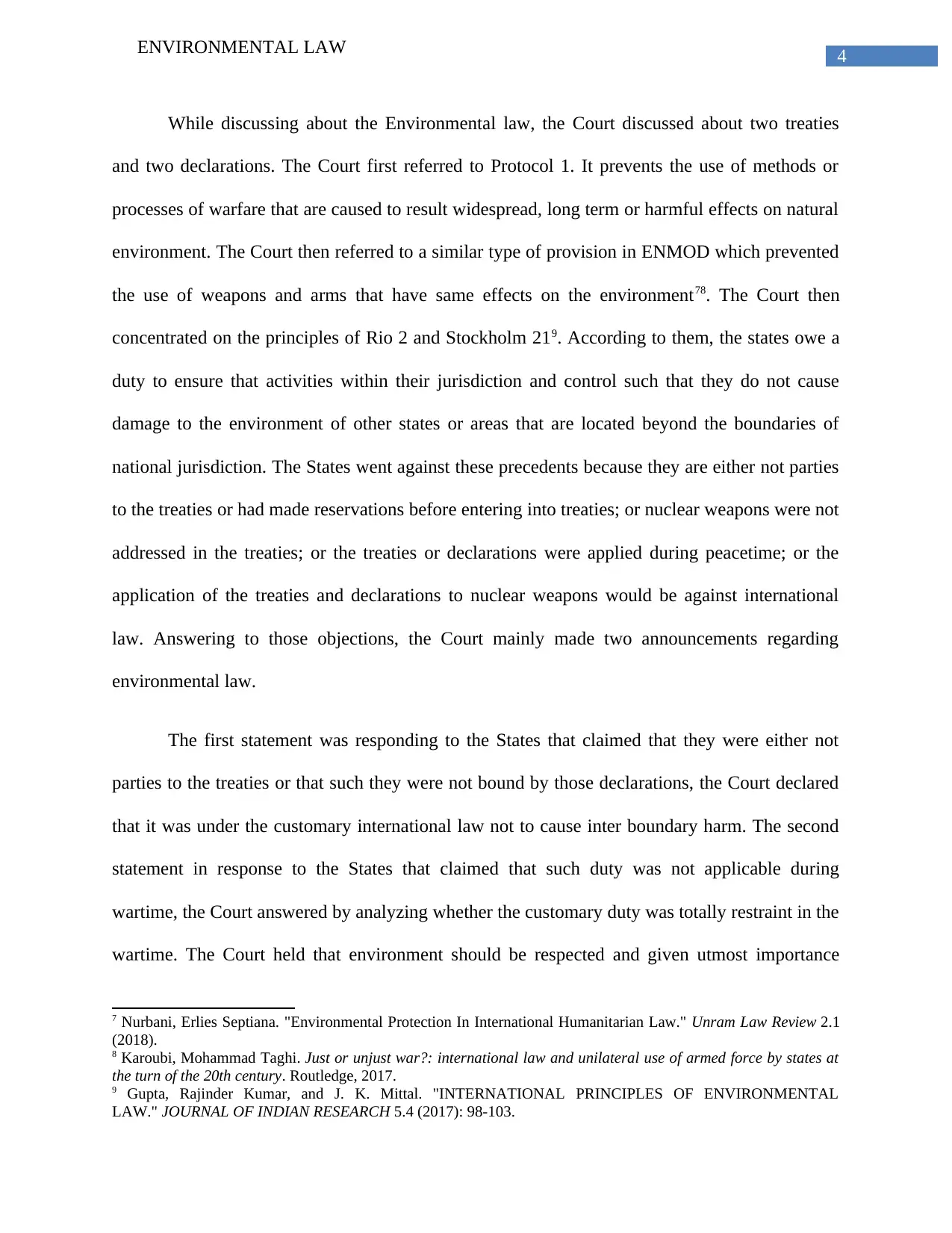
4ENVIRONMENTAL LAW
While discussing about the Environmental law, the Court discussed about two treaties
and two declarations. The Court first referred to Protocol 1. It prevents the use of methods or
processes of warfare that are caused to result widespread, long term or harmful effects on natural
environment. The Court then referred to a similar type of provision in ENMOD which prevented
the use of weapons and arms that have same effects on the environment78. The Court then
concentrated on the principles of Rio 2 and Stockholm 219. According to them, the states owe a
duty to ensure that activities within their jurisdiction and control such that they do not cause
damage to the environment of other states or areas that are located beyond the boundaries of
national jurisdiction. The States went against these precedents because they are either not parties
to the treaties or had made reservations before entering into treaties; or nuclear weapons were not
addressed in the treaties; or the treaties or declarations were applied during peacetime; or the
application of the treaties and declarations to nuclear weapons would be against international
law. Answering to those objections, the Court mainly made two announcements regarding
environmental law.
The first statement was responding to the States that claimed that they were either not
parties to the treaties or that such they were not bound by those declarations, the Court declared
that it was under the customary international law not to cause inter boundary harm. The second
statement in response to the States that claimed that such duty was not applicable during
wartime, the Court answered by analyzing whether the customary duty was totally restraint in the
wartime. The Court held that environment should be respected and given utmost importance
7 Nurbani, Erlies Septiana. "Environmental Protection In International Humanitarian Law." Unram Law Review 2.1
(2018).
8 Karoubi, Mohammad Taghi. Just or unjust war?: international law and unilateral use of armed force by states at
the turn of the 20th century. Routledge, 2017.
9 Gupta, Rajinder Kumar, and J. K. Mittal. "INTERNATIONAL PRINCIPLES OF ENVIRONMENTAL
LAW." JOURNAL OF INDIAN RESEARCH 5.4 (2017): 98-103.
While discussing about the Environmental law, the Court discussed about two treaties
and two declarations. The Court first referred to Protocol 1. It prevents the use of methods or
processes of warfare that are caused to result widespread, long term or harmful effects on natural
environment. The Court then referred to a similar type of provision in ENMOD which prevented
the use of weapons and arms that have same effects on the environment78. The Court then
concentrated on the principles of Rio 2 and Stockholm 219. According to them, the states owe a
duty to ensure that activities within their jurisdiction and control such that they do not cause
damage to the environment of other states or areas that are located beyond the boundaries of
national jurisdiction. The States went against these precedents because they are either not parties
to the treaties or had made reservations before entering into treaties; or nuclear weapons were not
addressed in the treaties; or the treaties or declarations were applied during peacetime; or the
application of the treaties and declarations to nuclear weapons would be against international
law. Answering to those objections, the Court mainly made two announcements regarding
environmental law.
The first statement was responding to the States that claimed that they were either not
parties to the treaties or that such they were not bound by those declarations, the Court declared
that it was under the customary international law not to cause inter boundary harm. The second
statement in response to the States that claimed that such duty was not applicable during
wartime, the Court answered by analyzing whether the customary duty was totally restraint in the
wartime. The Court held that environment should be respected and given utmost importance
7 Nurbani, Erlies Septiana. "Environmental Protection In International Humanitarian Law." Unram Law Review 2.1
(2018).
8 Karoubi, Mohammad Taghi. Just or unjust war?: international law and unilateral use of armed force by states at
the turn of the 20th century. Routledge, 2017.
9 Gupta, Rajinder Kumar, and J. K. Mittal. "INTERNATIONAL PRINCIPLES OF ENVIRONMENTAL
LAW." JOURNAL OF INDIAN RESEARCH 5.4 (2017): 98-103.
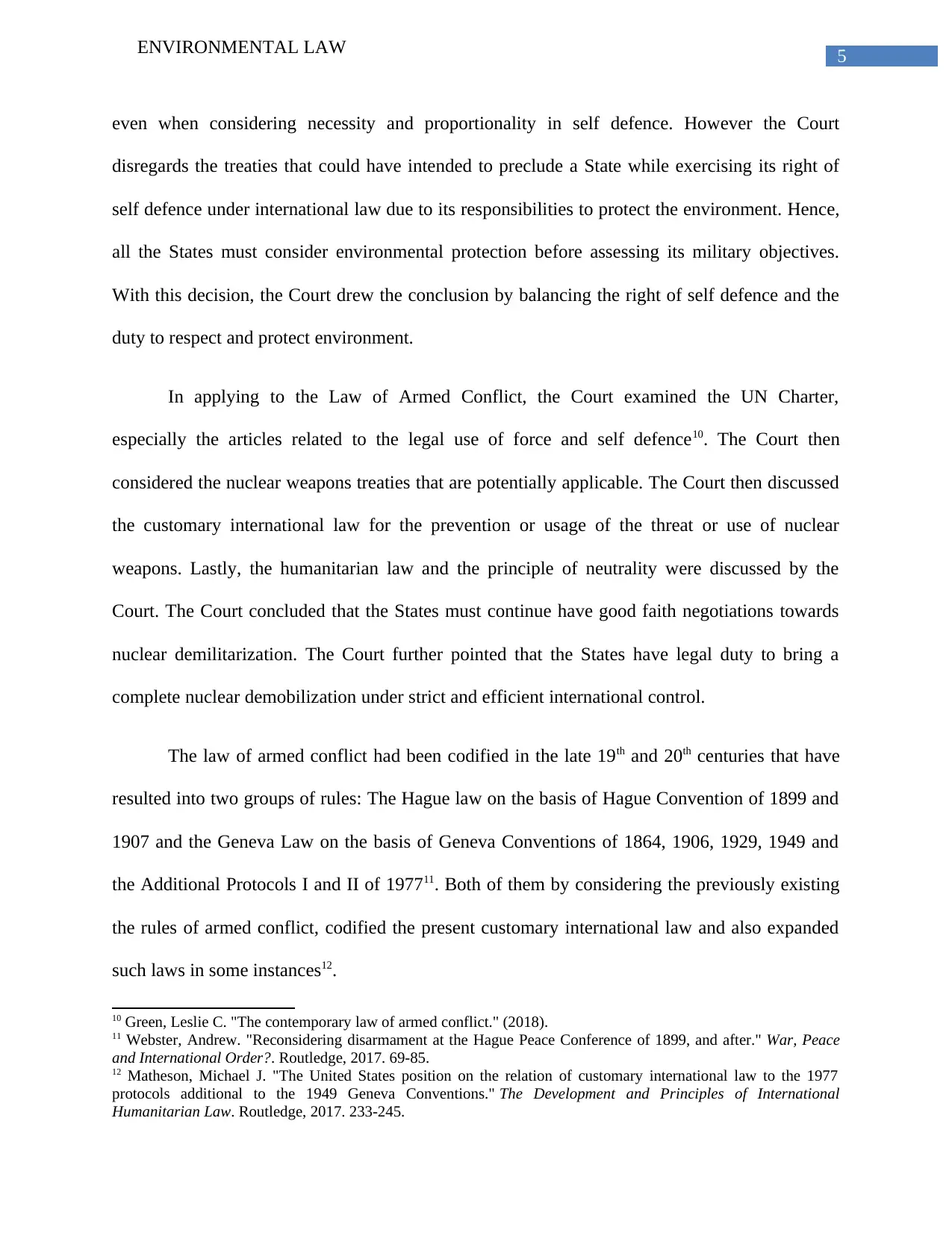
5ENVIRONMENTAL LAW
even when considering necessity and proportionality in self defence. However the Court
disregards the treaties that could have intended to preclude a State while exercising its right of
self defence under international law due to its responsibilities to protect the environment. Hence,
all the States must consider environmental protection before assessing its military objectives.
With this decision, the Court drew the conclusion by balancing the right of self defence and the
duty to respect and protect environment.
In applying to the Law of Armed Conflict, the Court examined the UN Charter,
especially the articles related to the legal use of force and self defence10. The Court then
considered the nuclear weapons treaties that are potentially applicable. The Court then discussed
the customary international law for the prevention or usage of the threat or use of nuclear
weapons. Lastly, the humanitarian law and the principle of neutrality were discussed by the
Court. The Court concluded that the States must continue have good faith negotiations towards
nuclear demilitarization. The Court further pointed that the States have legal duty to bring a
complete nuclear demobilization under strict and efficient international control.
The law of armed conflict had been codified in the late 19th and 20th centuries that have
resulted into two groups of rules: The Hague law on the basis of Hague Convention of 1899 and
1907 and the Geneva Law on the basis of Geneva Conventions of 1864, 1906, 1929, 1949 and
the Additional Protocols I and II of 197711. Both of them by considering the previously existing
the rules of armed conflict, codified the present customary international law and also expanded
such laws in some instances12.
10 Green, Leslie C. "The contemporary law of armed conflict." (2018).
11 Webster, Andrew. "Reconsidering disarmament at the Hague Peace Conference of 1899, and after." War, Peace
and International Order?. Routledge, 2017. 69-85.
12 Matheson, Michael J. "The United States position on the relation of customary international law to the 1977
protocols additional to the 1949 Geneva Conventions." The Development and Principles of International
Humanitarian Law. Routledge, 2017. 233-245.
even when considering necessity and proportionality in self defence. However the Court
disregards the treaties that could have intended to preclude a State while exercising its right of
self defence under international law due to its responsibilities to protect the environment. Hence,
all the States must consider environmental protection before assessing its military objectives.
With this decision, the Court drew the conclusion by balancing the right of self defence and the
duty to respect and protect environment.
In applying to the Law of Armed Conflict, the Court examined the UN Charter,
especially the articles related to the legal use of force and self defence10. The Court then
considered the nuclear weapons treaties that are potentially applicable. The Court then discussed
the customary international law for the prevention or usage of the threat or use of nuclear
weapons. Lastly, the humanitarian law and the principle of neutrality were discussed by the
Court. The Court concluded that the States must continue have good faith negotiations towards
nuclear demilitarization. The Court further pointed that the States have legal duty to bring a
complete nuclear demobilization under strict and efficient international control.
The law of armed conflict had been codified in the late 19th and 20th centuries that have
resulted into two groups of rules: The Hague law on the basis of Hague Convention of 1899 and
1907 and the Geneva Law on the basis of Geneva Conventions of 1864, 1906, 1929, 1949 and
the Additional Protocols I and II of 197711. Both of them by considering the previously existing
the rules of armed conflict, codified the present customary international law and also expanded
such laws in some instances12.
10 Green, Leslie C. "The contemporary law of armed conflict." (2018).
11 Webster, Andrew. "Reconsidering disarmament at the Hague Peace Conference of 1899, and after." War, Peace
and International Order?. Routledge, 2017. 69-85.
12 Matheson, Michael J. "The United States position on the relation of customary international law to the 1977
protocols additional to the 1949 Geneva Conventions." The Development and Principles of International
Humanitarian Law. Routledge, 2017. 233-245.
⊘ This is a preview!⊘
Do you want full access?
Subscribe today to unlock all pages.

Trusted by 1+ million students worldwide
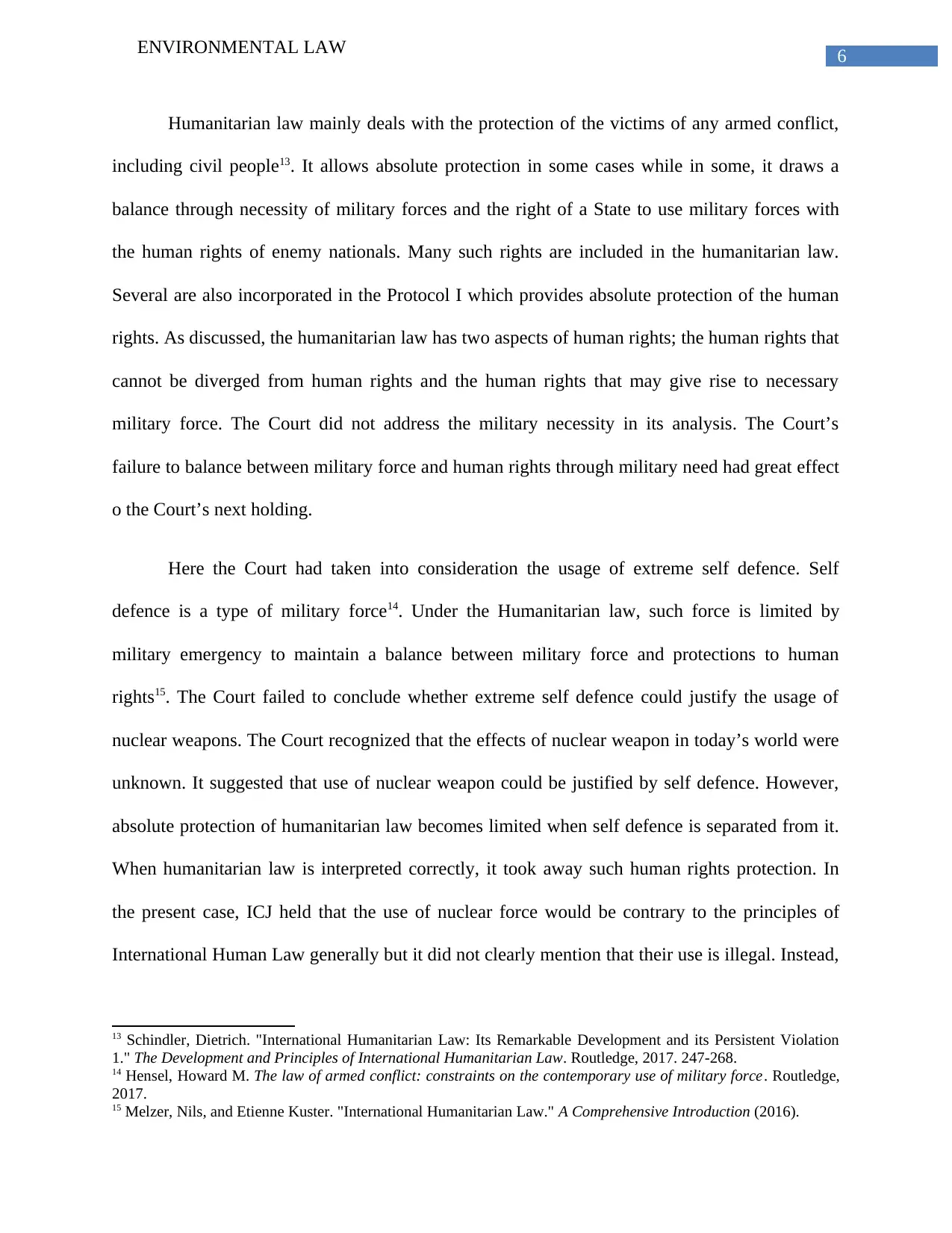
6ENVIRONMENTAL LAW
Humanitarian law mainly deals with the protection of the victims of any armed conflict,
including civil people13. It allows absolute protection in some cases while in some, it draws a
balance through necessity of military forces and the right of a State to use military forces with
the human rights of enemy nationals. Many such rights are included in the humanitarian law.
Several are also incorporated in the Protocol I which provides absolute protection of the human
rights. As discussed, the humanitarian law has two aspects of human rights; the human rights that
cannot be diverged from human rights and the human rights that may give rise to necessary
military force. The Court did not address the military necessity in its analysis. The Court’s
failure to balance between military force and human rights through military need had great effect
o the Court’s next holding.
Here the Court had taken into consideration the usage of extreme self defence. Self
defence is a type of military force14. Under the Humanitarian law, such force is limited by
military emergency to maintain a balance between military force and protections to human
rights15. The Court failed to conclude whether extreme self defence could justify the usage of
nuclear weapons. The Court recognized that the effects of nuclear weapon in today’s world were
unknown. It suggested that use of nuclear weapon could be justified by self defence. However,
absolute protection of humanitarian law becomes limited when self defence is separated from it.
When humanitarian law is interpreted correctly, it took away such human rights protection. In
the present case, ICJ held that the use of nuclear force would be contrary to the principles of
International Human Law generally but it did not clearly mention that their use is illegal. Instead,
13 Schindler, Dietrich. "International Humanitarian Law: Its Remarkable Development and its Persistent Violation
1." The Development and Principles of International Humanitarian Law. Routledge, 2017. 247-268.
14 Hensel, Howard M. The law of armed conflict: constraints on the contemporary use of military force. Routledge,
2017.
15 Melzer, Nils, and Etienne Kuster. "International Humanitarian Law." A Comprehensive Introduction (2016).
Humanitarian law mainly deals with the protection of the victims of any armed conflict,
including civil people13. It allows absolute protection in some cases while in some, it draws a
balance through necessity of military forces and the right of a State to use military forces with
the human rights of enemy nationals. Many such rights are included in the humanitarian law.
Several are also incorporated in the Protocol I which provides absolute protection of the human
rights. As discussed, the humanitarian law has two aspects of human rights; the human rights that
cannot be diverged from human rights and the human rights that may give rise to necessary
military force. The Court did not address the military necessity in its analysis. The Court’s
failure to balance between military force and human rights through military need had great effect
o the Court’s next holding.
Here the Court had taken into consideration the usage of extreme self defence. Self
defence is a type of military force14. Under the Humanitarian law, such force is limited by
military emergency to maintain a balance between military force and protections to human
rights15. The Court failed to conclude whether extreme self defence could justify the usage of
nuclear weapons. The Court recognized that the effects of nuclear weapon in today’s world were
unknown. It suggested that use of nuclear weapon could be justified by self defence. However,
absolute protection of humanitarian law becomes limited when self defence is separated from it.
When humanitarian law is interpreted correctly, it took away such human rights protection. In
the present case, ICJ held that the use of nuclear force would be contrary to the principles of
International Human Law generally but it did not clearly mention that their use is illegal. Instead,
13 Schindler, Dietrich. "International Humanitarian Law: Its Remarkable Development and its Persistent Violation
1." The Development and Principles of International Humanitarian Law. Routledge, 2017. 247-268.
14 Hensel, Howard M. The law of armed conflict: constraints on the contemporary use of military force. Routledge,
2017.
15 Melzer, Nils, and Etienne Kuster. "International Humanitarian Law." A Comprehensive Introduction (2016).
Paraphrase This Document
Need a fresh take? Get an instant paraphrase of this document with our AI Paraphraser
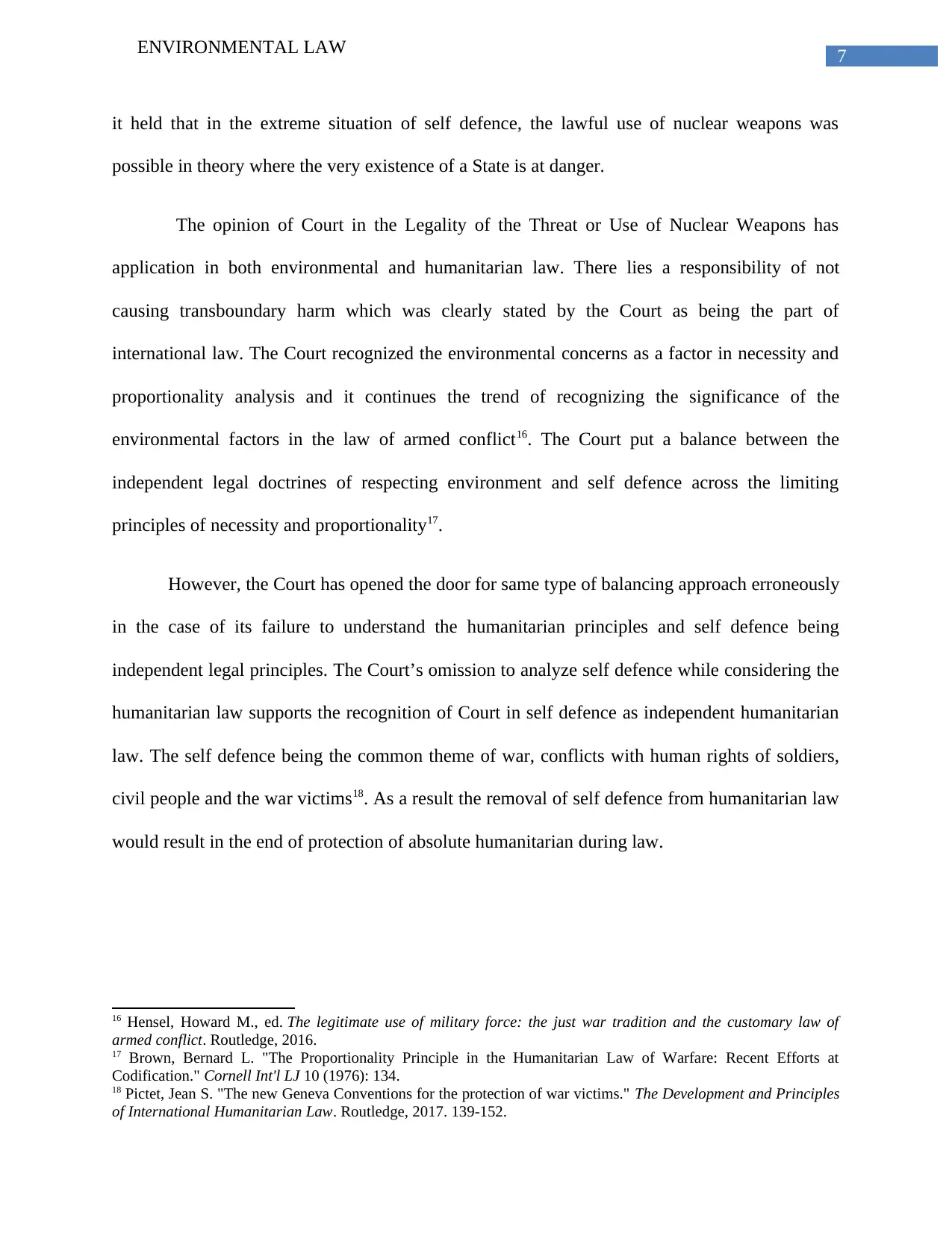
7ENVIRONMENTAL LAW
it held that in the extreme situation of self defence, the lawful use of nuclear weapons was
possible in theory where the very existence of a State is at danger.
The opinion of Court in the Legality of the Threat or Use of Nuclear Weapons has
application in both environmental and humanitarian law. There lies a responsibility of not
causing transboundary harm which was clearly stated by the Court as being the part of
international law. The Court recognized the environmental concerns as a factor in necessity and
proportionality analysis and it continues the trend of recognizing the significance of the
environmental factors in the law of armed conflict16. The Court put a balance between the
independent legal doctrines of respecting environment and self defence across the limiting
principles of necessity and proportionality17.
However, the Court has opened the door for same type of balancing approach erroneously
in the case of its failure to understand the humanitarian principles and self defence being
independent legal principles. The Court’s omission to analyze self defence while considering the
humanitarian law supports the recognition of Court in self defence as independent humanitarian
law. The self defence being the common theme of war, conflicts with human rights of soldiers,
civil people and the war victims18. As a result the removal of self defence from humanitarian law
would result in the end of protection of absolute humanitarian during law.
16 Hensel, Howard M., ed. The legitimate use of military force: the just war tradition and the customary law of
armed conflict. Routledge, 2016.
17 Brown, Bernard L. "The Proportionality Principle in the Humanitarian Law of Warfare: Recent Efforts at
Codification." Cornell Int'l LJ 10 (1976): 134.
18 Pictet, Jean S. "The new Geneva Conventions for the protection of war victims." The Development and Principles
of International Humanitarian Law. Routledge, 2017. 139-152.
it held that in the extreme situation of self defence, the lawful use of nuclear weapons was
possible in theory where the very existence of a State is at danger.
The opinion of Court in the Legality of the Threat or Use of Nuclear Weapons has
application in both environmental and humanitarian law. There lies a responsibility of not
causing transboundary harm which was clearly stated by the Court as being the part of
international law. The Court recognized the environmental concerns as a factor in necessity and
proportionality analysis and it continues the trend of recognizing the significance of the
environmental factors in the law of armed conflict16. The Court put a balance between the
independent legal doctrines of respecting environment and self defence across the limiting
principles of necessity and proportionality17.
However, the Court has opened the door for same type of balancing approach erroneously
in the case of its failure to understand the humanitarian principles and self defence being
independent legal principles. The Court’s omission to analyze self defence while considering the
humanitarian law supports the recognition of Court in self defence as independent humanitarian
law. The self defence being the common theme of war, conflicts with human rights of soldiers,
civil people and the war victims18. As a result the removal of self defence from humanitarian law
would result in the end of protection of absolute humanitarian during law.
16 Hensel, Howard M., ed. The legitimate use of military force: the just war tradition and the customary law of
armed conflict. Routledge, 2016.
17 Brown, Bernard L. "The Proportionality Principle in the Humanitarian Law of Warfare: Recent Efforts at
Codification." Cornell Int'l LJ 10 (1976): 134.
18 Pictet, Jean S. "The new Geneva Conventions for the protection of war victims." The Development and Principles
of International Humanitarian Law. Routledge, 2017. 139-152.
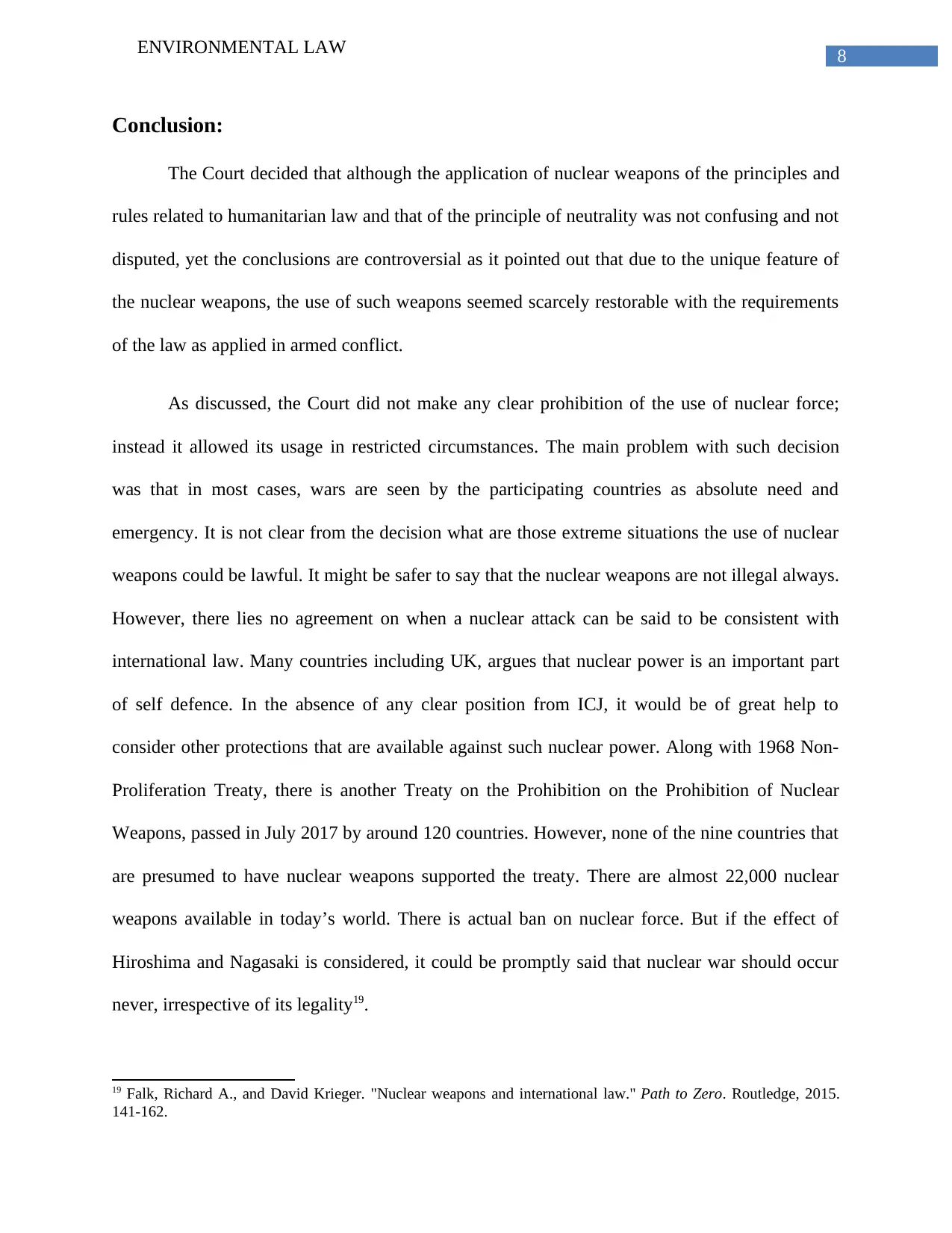
8ENVIRONMENTAL LAW
Conclusion:
The Court decided that although the application of nuclear weapons of the principles and
rules related to humanitarian law and that of the principle of neutrality was not confusing and not
disputed, yet the conclusions are controversial as it pointed out that due to the unique feature of
the nuclear weapons, the use of such weapons seemed scarcely restorable with the requirements
of the law as applied in armed conflict.
As discussed, the Court did not make any clear prohibition of the use of nuclear force;
instead it allowed its usage in restricted circumstances. The main problem with such decision
was that in most cases, wars are seen by the participating countries as absolute need and
emergency. It is not clear from the decision what are those extreme situations the use of nuclear
weapons could be lawful. It might be safer to say that the nuclear weapons are not illegal always.
However, there lies no agreement on when a nuclear attack can be said to be consistent with
international law. Many countries including UK, argues that nuclear power is an important part
of self defence. In the absence of any clear position from ICJ, it would be of great help to
consider other protections that are available against such nuclear power. Along with 1968 Non-
Proliferation Treaty, there is another Treaty on the Prohibition on the Prohibition of Nuclear
Weapons, passed in July 2017 by around 120 countries. However, none of the nine countries that
are presumed to have nuclear weapons supported the treaty. There are almost 22,000 nuclear
weapons available in today’s world. There is actual ban on nuclear force. But if the effect of
Hiroshima and Nagasaki is considered, it could be promptly said that nuclear war should occur
never, irrespective of its legality19.
19 Falk, Richard A., and David Krieger. "Nuclear weapons and international law." Path to Zero. Routledge, 2015.
141-162.
Conclusion:
The Court decided that although the application of nuclear weapons of the principles and
rules related to humanitarian law and that of the principle of neutrality was not confusing and not
disputed, yet the conclusions are controversial as it pointed out that due to the unique feature of
the nuclear weapons, the use of such weapons seemed scarcely restorable with the requirements
of the law as applied in armed conflict.
As discussed, the Court did not make any clear prohibition of the use of nuclear force;
instead it allowed its usage in restricted circumstances. The main problem with such decision
was that in most cases, wars are seen by the participating countries as absolute need and
emergency. It is not clear from the decision what are those extreme situations the use of nuclear
weapons could be lawful. It might be safer to say that the nuclear weapons are not illegal always.
However, there lies no agreement on when a nuclear attack can be said to be consistent with
international law. Many countries including UK, argues that nuclear power is an important part
of self defence. In the absence of any clear position from ICJ, it would be of great help to
consider other protections that are available against such nuclear power. Along with 1968 Non-
Proliferation Treaty, there is another Treaty on the Prohibition on the Prohibition of Nuclear
Weapons, passed in July 2017 by around 120 countries. However, none of the nine countries that
are presumed to have nuclear weapons supported the treaty. There are almost 22,000 nuclear
weapons available in today’s world. There is actual ban on nuclear force. But if the effect of
Hiroshima and Nagasaki is considered, it could be promptly said that nuclear war should occur
never, irrespective of its legality19.
19 Falk, Richard A., and David Krieger. "Nuclear weapons and international law." Path to Zero. Routledge, 2015.
141-162.
⊘ This is a preview!⊘
Do you want full access?
Subscribe today to unlock all pages.

Trusted by 1+ million students worldwide
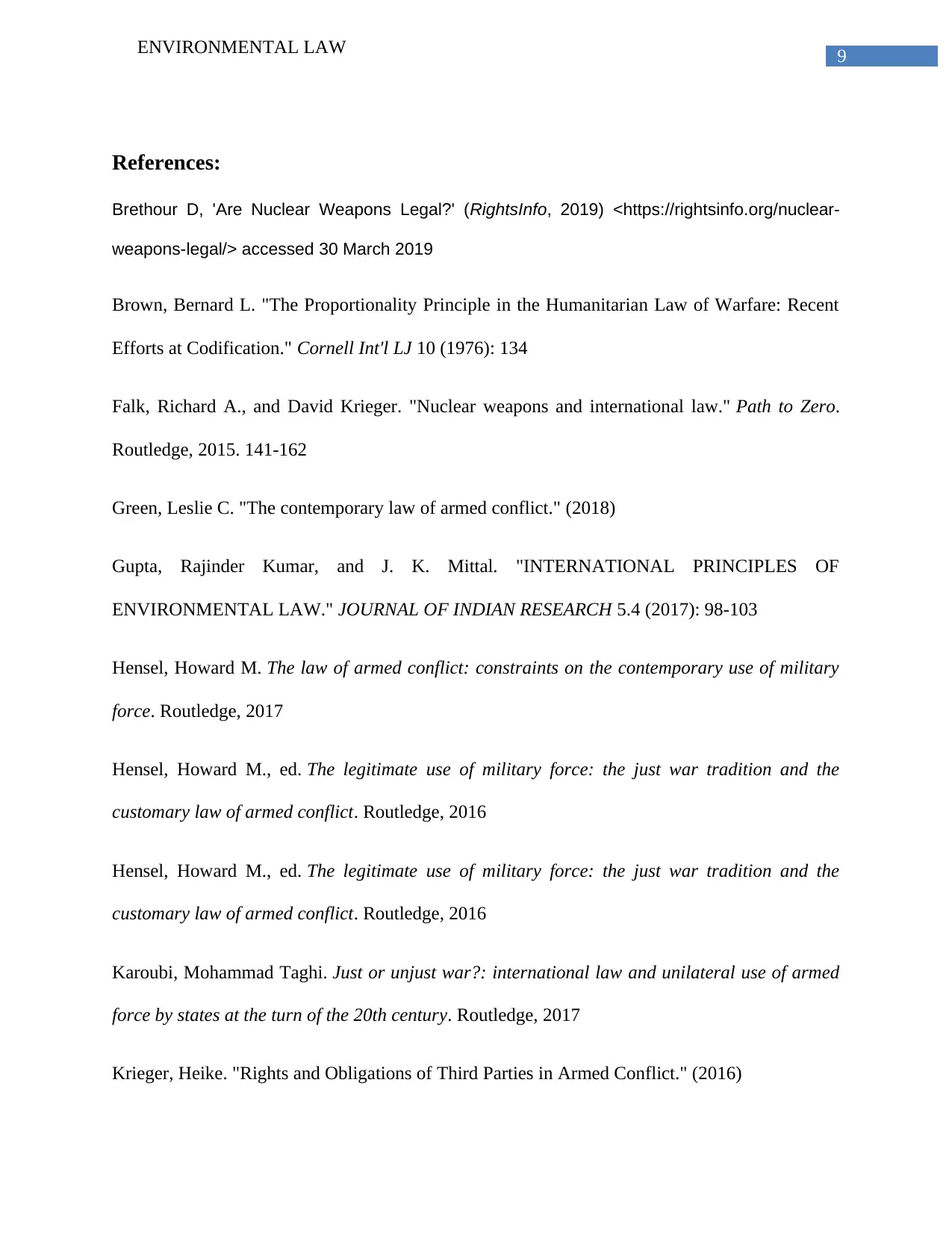
9ENVIRONMENTAL LAW
References:
Brethour D, 'Are Nuclear Weapons Legal?' (RightsInfo, 2019) <https://rightsinfo.org/nuclear-
weapons-legal/> accessed 30 March 2019
Brown, Bernard L. "The Proportionality Principle in the Humanitarian Law of Warfare: Recent
Efforts at Codification." Cornell Int'l LJ 10 (1976): 134
Falk, Richard A., and David Krieger. "Nuclear weapons and international law." Path to Zero.
Routledge, 2015. 141-162
Green, Leslie C. "The contemporary law of armed conflict." (2018)
Gupta, Rajinder Kumar, and J. K. Mittal. "INTERNATIONAL PRINCIPLES OF
ENVIRONMENTAL LAW." JOURNAL OF INDIAN RESEARCH 5.4 (2017): 98-103
Hensel, Howard M. The law of armed conflict: constraints on the contemporary use of military
force. Routledge, 2017
Hensel, Howard M., ed. The legitimate use of military force: the just war tradition and the
customary law of armed conflict. Routledge, 2016
Hensel, Howard M., ed. The legitimate use of military force: the just war tradition and the
customary law of armed conflict. Routledge, 2016
Karoubi, Mohammad Taghi. Just or unjust war?: international law and unilateral use of armed
force by states at the turn of the 20th century. Routledge, 2017
Krieger, Heike. "Rights and Obligations of Third Parties in Armed Conflict." (2016)
References:
Brethour D, 'Are Nuclear Weapons Legal?' (RightsInfo, 2019) <https://rightsinfo.org/nuclear-
weapons-legal/> accessed 30 March 2019
Brown, Bernard L. "The Proportionality Principle in the Humanitarian Law of Warfare: Recent
Efforts at Codification." Cornell Int'l LJ 10 (1976): 134
Falk, Richard A., and David Krieger. "Nuclear weapons and international law." Path to Zero.
Routledge, 2015. 141-162
Green, Leslie C. "The contemporary law of armed conflict." (2018)
Gupta, Rajinder Kumar, and J. K. Mittal. "INTERNATIONAL PRINCIPLES OF
ENVIRONMENTAL LAW." JOURNAL OF INDIAN RESEARCH 5.4 (2017): 98-103
Hensel, Howard M. The law of armed conflict: constraints on the contemporary use of military
force. Routledge, 2017
Hensel, Howard M., ed. The legitimate use of military force: the just war tradition and the
customary law of armed conflict. Routledge, 2016
Hensel, Howard M., ed. The legitimate use of military force: the just war tradition and the
customary law of armed conflict. Routledge, 2016
Karoubi, Mohammad Taghi. Just or unjust war?: international law and unilateral use of armed
force by states at the turn of the 20th century. Routledge, 2017
Krieger, Heike. "Rights and Obligations of Third Parties in Armed Conflict." (2016)
Paraphrase This Document
Need a fresh take? Get an instant paraphrase of this document with our AI Paraphraser
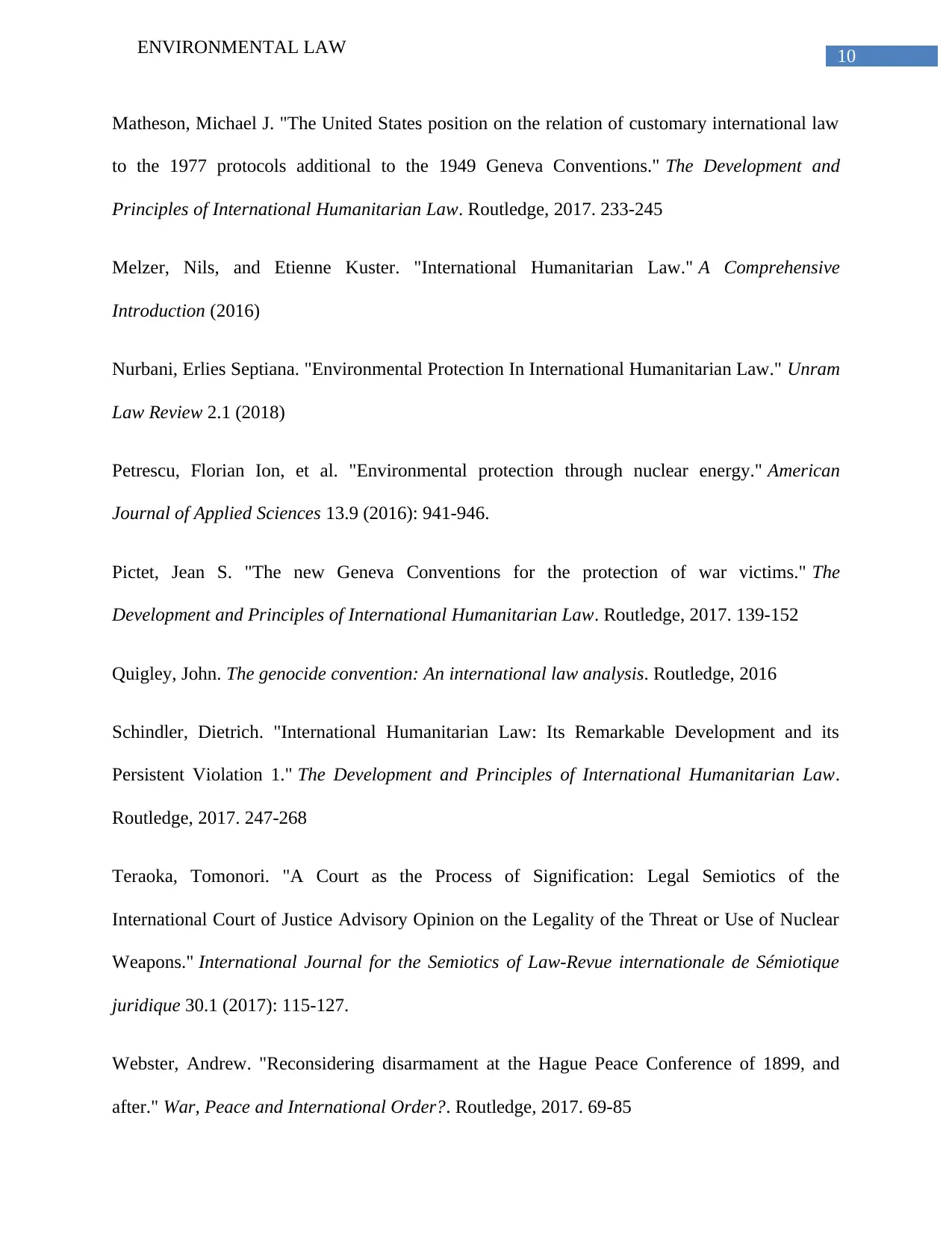
10ENVIRONMENTAL LAW
Matheson, Michael J. "The United States position on the relation of customary international law
to the 1977 protocols additional to the 1949 Geneva Conventions." The Development and
Principles of International Humanitarian Law. Routledge, 2017. 233-245
Melzer, Nils, and Etienne Kuster. "International Humanitarian Law." A Comprehensive
Introduction (2016)
Nurbani, Erlies Septiana. "Environmental Protection In International Humanitarian Law." Unram
Law Review 2.1 (2018)
Petrescu, Florian Ion, et al. "Environmental protection through nuclear energy." American
Journal of Applied Sciences 13.9 (2016): 941-946.
Pictet, Jean S. "The new Geneva Conventions for the protection of war victims." The
Development and Principles of International Humanitarian Law. Routledge, 2017. 139-152
Quigley, John. The genocide convention: An international law analysis. Routledge, 2016
Schindler, Dietrich. "International Humanitarian Law: Its Remarkable Development and its
Persistent Violation 1." The Development and Principles of International Humanitarian Law.
Routledge, 2017. 247-268
Teraoka, Tomonori. "A Court as the Process of Signification: Legal Semiotics of the
International Court of Justice Advisory Opinion on the Legality of the Threat or Use of Nuclear
Weapons." International Journal for the Semiotics of Law-Revue internationale de Sémiotique
juridique 30.1 (2017): 115-127.
Webster, Andrew. "Reconsidering disarmament at the Hague Peace Conference of 1899, and
after." War, Peace and International Order?. Routledge, 2017. 69-85
Matheson, Michael J. "The United States position on the relation of customary international law
to the 1977 protocols additional to the 1949 Geneva Conventions." The Development and
Principles of International Humanitarian Law. Routledge, 2017. 233-245
Melzer, Nils, and Etienne Kuster. "International Humanitarian Law." A Comprehensive
Introduction (2016)
Nurbani, Erlies Septiana. "Environmental Protection In International Humanitarian Law." Unram
Law Review 2.1 (2018)
Petrescu, Florian Ion, et al. "Environmental protection through nuclear energy." American
Journal of Applied Sciences 13.9 (2016): 941-946.
Pictet, Jean S. "The new Geneva Conventions for the protection of war victims." The
Development and Principles of International Humanitarian Law. Routledge, 2017. 139-152
Quigley, John. The genocide convention: An international law analysis. Routledge, 2016
Schindler, Dietrich. "International Humanitarian Law: Its Remarkable Development and its
Persistent Violation 1." The Development and Principles of International Humanitarian Law.
Routledge, 2017. 247-268
Teraoka, Tomonori. "A Court as the Process of Signification: Legal Semiotics of the
International Court of Justice Advisory Opinion on the Legality of the Threat or Use of Nuclear
Weapons." International Journal for the Semiotics of Law-Revue internationale de Sémiotique
juridique 30.1 (2017): 115-127.
Webster, Andrew. "Reconsidering disarmament at the Hague Peace Conference of 1899, and
after." War, Peace and International Order?. Routledge, 2017. 69-85
1 out of 11
Your All-in-One AI-Powered Toolkit for Academic Success.
+13062052269
info@desklib.com
Available 24*7 on WhatsApp / Email
![[object Object]](/_next/static/media/star-bottom.7253800d.svg)
Unlock your academic potential
Copyright © 2020–2025 A2Z Services. All Rights Reserved. Developed and managed by ZUCOL.


